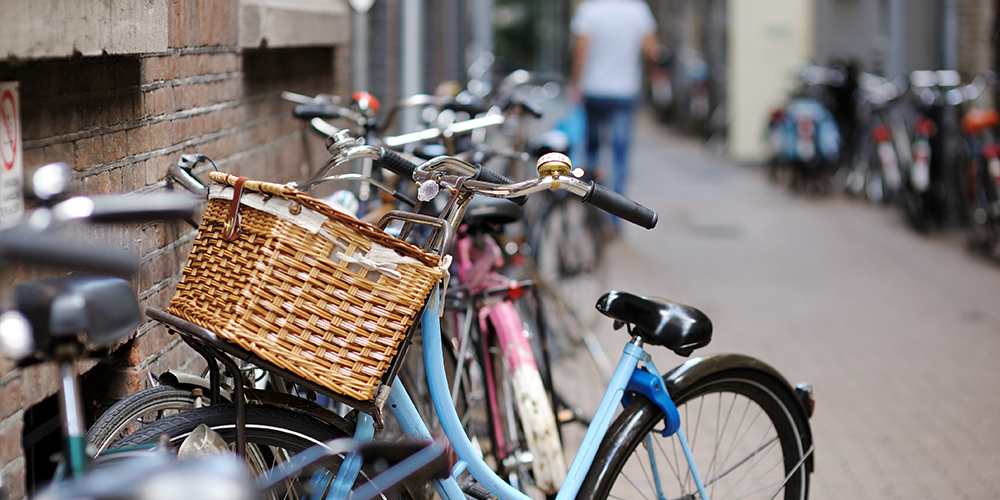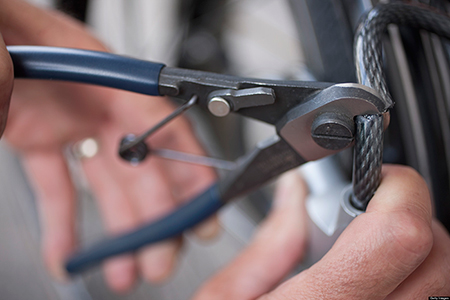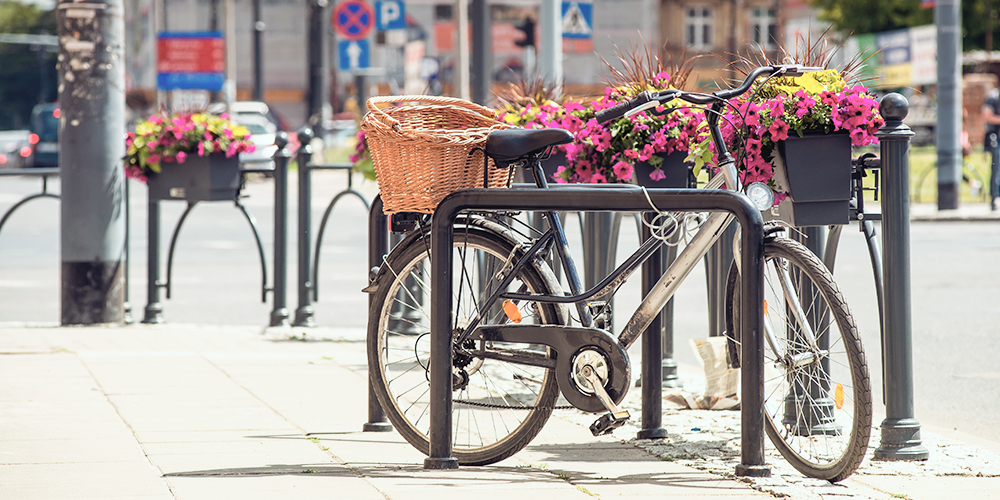Lock Blog
A resource for consumers, locksmiths, and security professionals
A resource for consumers, locksmiths, and security professionals

Cycling is an important part of many people’s lives. It is how people get to work, how they exercise, and the way they just generally get around. As the community grows, so does the opportunity for theft. A growing concern for those that ride is often how they will secure their bike. How secure will the bike be when it is locked up? In this article, we will take a look at some of the statistics, some of the expert advice, and do some speculating. What are the criminals doing to steal these bikes? If we know the methods of attack we will better understand the available protections. What does the market offer crooks? And what does the market offer bike users, in terms of protection?
The FBI’s most recent statistic on bicycle theft has the number at 190,703 stolen annually. The claim of most bicycle centered websites is that the number is much higher. While searching around, I found sites quoting numbers as high as 1.5 million thefts annually. I was unable to find the source for this statistic on the National Bike Registry website and found that their Wikipedia page has a “citation needed” note by this figure. The disparity between these numbers is quite great. The reason most cyclists will claim for the drastic difference is that the crime goes unreported. Because of how low the recovery rate is for bicycles most cyclists are not very interested in bothering the police.
The Bike Index is a similar organization to the National Bike Registry, in that it registers your bicycle with several agencies and departments. The Bike Index has registered 56,233 bikes and it has recovered 2,569 of them. That is a less than 5% chance of getting your stolen bike back if you register it with the bike index. Compare that to the number the FBI gives, and it becomes about a 1% chance of recovery. The most comprehensive study of bike theft was done in Quebec Canada in the city of Montreal. The clearance rate for that city is 2.4%, which seems average. But out of all the bikes stolen during the study, 22 of them were registered with photographic documentation. None of those 22 registered bikes were recovered. Both registries having a 100% and a 95% failure rate, respectively.
The same study in Canada found that 76% of the bikes that were being stolen were valued under $500. The study concluded that people with more expensive bikes took greater precautions in securing them. So when some articles recommend, getting a cheaper bike, I am not sure what they are thinking. These bikes are most often going to be sold dirt cheap, but even that is a profit for a criminal. These are crimes of convenience. People may go hunting for expensive bikes, but if you secure them right, no one is going to waste their time. If your bike is not protected that is all the incentive that a person needs to take it. If they can get $50 for the bike then that is a net profit of $50, because what are the chances they paid for the tools they are using?

With brute force attacks, the lock, the chain, the anchor, or the bike is going to be broken. Commonly the thief will use a pair of bolt cutters and cut the lock or the chain. Whatever is weaker will be cut. More serious criminals might use and angle grinder to cut the chain or lock. They might break the lock or chain by striking the metal with a hammer. Liquid nitrogen or another freezing agent might also be used to weaken the metal. The lock could be drilled so that it can be opened with a flat blade screwdriver. The lock may also be levered. Levering is when a pry bar is placed in the gap between the lock and the bike frame (in the case of U-locks). With the proper leverage, the lock or the frame of the bike will break. Any of these methods might also be used to destroy what the bike is secured to when you cannot use your own ground anchor. The anchor point might be weaker than a lock. If you secure your bike to a tree, the tree might be the thing that gets cut.
If the bike is not secured properly, the thief may not even need to use force. The bike can be disassembled. When wheels are not secured to your anchor point or bike frame, it leaves that wheel vulnerable. It might not even matter to a thief what type of tire you have. If it can be easily taken, then that may be enough reason for someone to take it. This can get the thief several parts of the bike or allow them to get the bike free from its security measures. Signs can also be disassembled quite easily. If you lock your bicycle onto a street sign, it may be easier for a criminal to unscrew the bolts on the sign and lift the bike up over the pole.
A lock bypass could technically be considered a convenience attack, but because it does take knowledge and is very similar to the lock picking process, we will separate it. When you bypass a lock, you are circumventing the lock cylinder and getting the device to release in another way. One of the most common examples is the Masterlock U-Lock bypass. By removing one side of the pen, you will have the only tool you need. If you place the pen into the tubular keyway of the lock and depress it as you turn it in the keyhole, the lock will open. Similarly, certain padlocks can be bypassed. A very commonly used padlock bypass is shimming. It will not work on every padlock type, but by placing a thin piece of metal on either side of the lock shackle and depressing them both, the shackle will release. When it comes to picking, almost any lock can be picked. But thieves do not pick locks. Picking takes quite a bit of practice, skill, and patience. Most often there are much easier ways to steal, and criminals often choose the path of least resistance. Even though there are few thieves that will try and pick a lock, it does not mean that you should forget about this protection.
With the knowledge of how people are stealing bikes, we should be able to talk about some possible solutions. When considering avenues of protection there is a balancing act between practicality, convenience, cost, and importance. Some people need quick access to their bike and cannot waste the time taking off a large chain and five locks. The price of the bike might make the owner feel like they cannot justify the cost of better protection. Every compromise you make is going to compromise your security. If you are serious about the safety of your bike the solutions will not be easy, they will not be cheap, and they will not be foolproof. Protection is a shield, not a force field. There will always be a way of undermining the levels of security, but the more comprehensive your protection is, the fewer thieves will try, and the fewer thieves will succeed. Security is about buying time. The more time it will take to get through your levels of protection, the higher chance the thief will be discovered before the crime is finished. And the higher the chance the thief might give up and move on.
Many cyclists prefer the U-Lock to the padlock, despite their long history, because it replaces the need for a chain. A U-Lock is often regarded as more convenient, for the user, but you are going to need more than one if you are discarding the chain lock altogether. If possible, place as many U-Locks on the bike as you can carry. The U-Lock will need to go around the anchor point, the frame, and wheel. It is important when you are buying your U-Lock to make sure both sides of the shackle release. If only one side of the shackle releases, then the thief will only need to cut one side. A double release will demand that both sides be cut, which will cost the criminal time.
When it comes to padlocks, the options are almost limitless. You can buy padlocks for a few dollars or a few thousand dollars. When you are buying a lock, what you should pay attention to is weight, thickness (both in the lock body and in the shackle), and a shroud (metal that will cover the sides of the shackle so there is less accessibility). Look for rounded cuts on the shackle of the lock as this will indicate that the lock has ball bearings. A padlock with ball bearings cannot be shimmed. Stay away from Master Lock products, as these are often not made of sturdy materials. And don’t be afraid to spend some money. With security, the price is often an indication of protection. Also, make sure you don’t grab the first lock you see at Home Depot.
It is not only about what lock you use, but about how many locks you use. Always think about layers when you are dealing with security. Two dissimilar high-quality locks are going to be quite the deterrent to a thief. This is a bicycle that they are stealing not a lock box or a treasure chest. The thief can see as plain as day what they are stealing. Having two locks on a bike that might not warrant that level of protection is a nonstarter for thieves. Back to the point of the profit in bike theft, the materials might not cost them anything, but their time is their expense. If they see that they will need to spend the time in removing several locks all of which require some different method, that person is going to make a value judgment. The time they will spend versus the worth of the bike.
If they can’t cut the lock, they will cut the chain. Knowing this, if you are going to use a chain you should try and get the sturdiest one possible. I would suggest having a high-security chain to add to the layers of your security. Chains can be secured at multiple points so that locks can be added and security can be changed. Chains also allow the user to weave between the wheels, frame, and anchor point. With high-security chain, the thief will need to make two cuts in one link similar to a full shackle release U-Lock.
The most important tool that the chain will need to be able to defeat is the bolt cutter. If the chain is not as hard as the bolt cutters then it will be cut. If the metal in the chain is harder than the bolt cutter then the bolt cutters will be damaged. This means that the chain will need to exceed a 48 rating on the Rockwell Hardness Scale (the hardness of top grade bolt cutters will be 62 on the high end). Take this into account when you are selecting a chain. If you are not big on research, the Pewag Hardened Square Line Chain meets this criterion with a 63 rating on the Rockwell scale. Something like the Pewag or any other chain will not prevent angle grinder attacks. The hardness will increase the time that it will take to cut the links, but eventually the angle grinder will overcome any chain.
If they can’t cut the lock, and they can’t cut the chain, then they will take it off the anchor point. An anchor point can be anything from a bike rack to a fence. As long as you can secure your locks and chain through or around a thick and solid material, you can anchor your bicycle there. Bad anchor points are things that can be easily cut, such as a tree. Any post that the bike can be slid up and out of (including signposts where the sign can be easily removed) is not a suitable option. Another concern is a pole that has been augmented by a criminal so that they can lift the pole out of the base with ease.
These are known colloquially as sucker poles. When you secure your bike to a sucker pole, the most you are doing is putting locks around your bike. If chains and U-Locks are interwoven through the frame and wheels, it can still be carried away, even though it cannot be ridden away. Sucker poles can be identified by checking to see if the pole has a lock bolt or if the bolt is securely fastened. You can also determine if the city has secured the pole. A secure pole will have a washer hammered between the stand and the pole to fill the gap and bind the two parts. Regardless of whether or not the bolt can be released, the washer will keep the pole locked to the base.

You cannot steal what you cannot find. Keep your bike out of sight whenever possible. If that is not a viable option, for whatever reason, keep the bike in sight. Make sure that you can see it, and check on it periodically. Sometimes a line of sight or obscurity will not be an option, so the next best thing is to try and find a quiet place to lock up our bike. Despite popular opinion, a loud and busy street is often a thief’s paradise. The noise of the street masks the noise of the theft. Foot traffic provides a great deal of camouflage. And the impersonal nature of busy areas makes it so people don’t know who owns of the bike. A quiet residential street has people that care about their homes and have an interest in the things that happen around the neighborhood. This again comes down to a line of sight issue. If you are not the one watching your possessions, the next best thing is for someone else to watch them.
Make sure that none of your locking devices are touching the ground. Anything that is laying on the ground, or anything that can be easily moved to rest on the ground, is susceptible to forced entry. By placing it on the ground, the thief has a surface that they can use to make striking and leveraging the metal more effective. The less gap you can leave between the lock and the bike, or the chain and the bike, will provide better security. Another easy precaution is to replace any quick release levers on your bike with Allen bolts or lug nuts. Quick release levers will make it easy for you to change a tire or adjust your seat, but they will make it just as easy for a criminal to disassemble the bike and steal the pieces. You can also hot glue a ball bearing into the hole on the Allen bolt. This will make it more difficult for you to change a tire, but a couple minutes of scraping out glue is going to be more trouble than most bike thieves want. If something seems like it would be inconvenient for you to deal with, then it has a high chance of deterring a thief.
At the end of the day, bikes are lightweight and can be disassembled. That means they can be carried away, and carried away in pieces. We don’t really know how many bike thefts there are, but it is a threat that every cyclist faces. Because bikes are functional they need to be easy enough to unlock, and the security must be light enough to travel. Several high-security locks and a high-security chain are the most secure and practical options for the general public. Your personal situation might include opportunities for better protection if your home or office offers a room to store your bike. Similarly, your situation might preclude many security measures if you need to make deliveries and cannot take your bike inside the buildings and are restricted in the time you have to lock and unlock your bike. So get big thick chains and big thick locks.
Find anchor points that will not leave your property vulnerable. It is not an easy task to keep something so public and light, safe, but that doesn’t mean it should be easy for someone else to take. Be as creative as possible with your security, but make sure that your methods stay practical. This article is not intended for use in criminal activity. Use this information to better protect yourself and your property. Feel free to share some of your tips and tricks in the comments below. Be sure when you are sharing that you do not compromise your own security.
Category: Buying Guides, How To's, Safety & Security